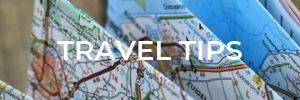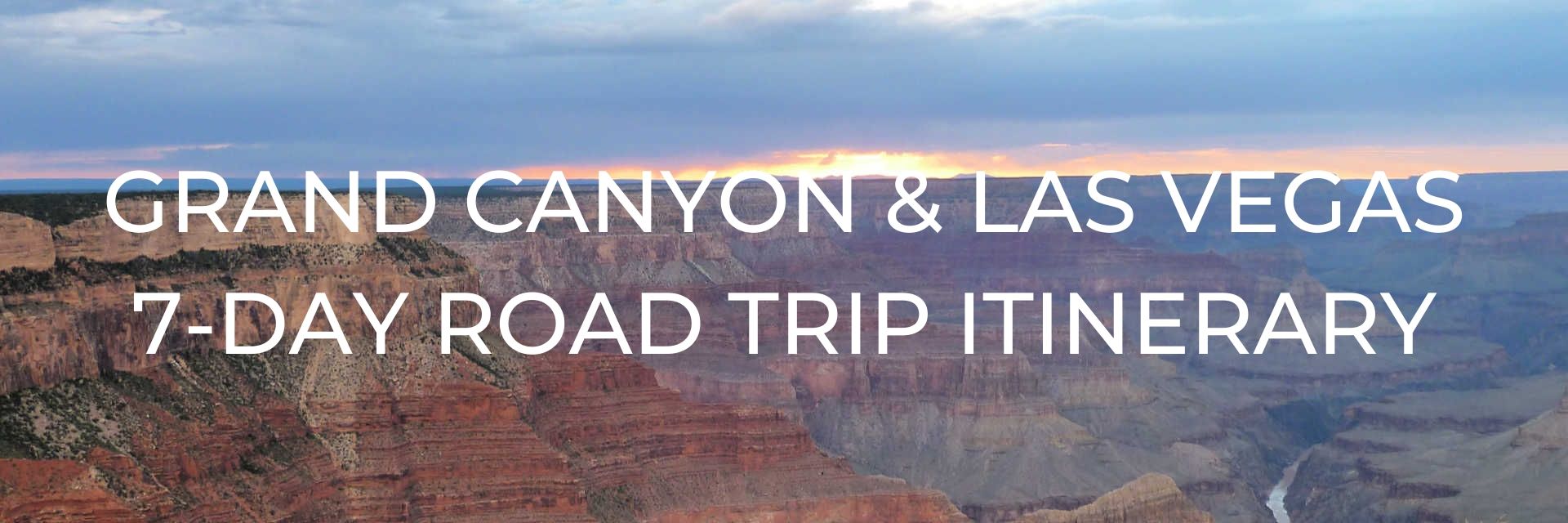
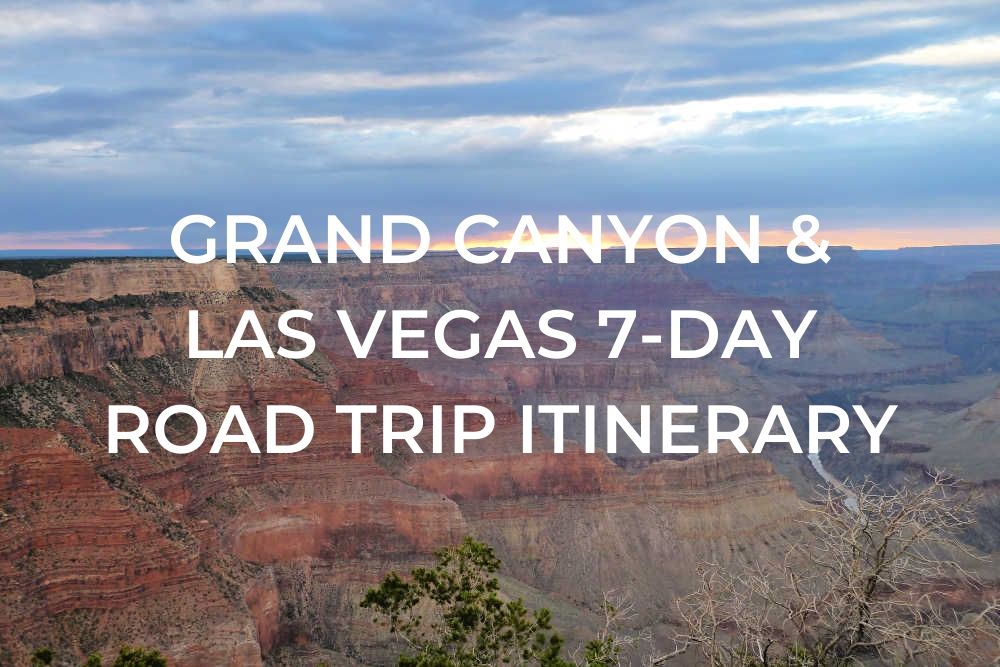
The Grand Canyon is on many peoples bucket list and a lot of people visit it as a day trip from Las Vegas. But, there is so much more to explore in the area, from man-made wonders to spectacular natural scenery and once in a lifetime adventures that we wanted to see more. So we put together this seven-day road trip that encircles the Grand Canyon and takes in a multitude of amazing places to see.
This suggested (and tested!) itinerary will help you get the most of this wonderful part of Arizona and Nevada. You’ll drive completely around the Grand Canyon, take a helicopter to the top of a butte, gaze at amazing scenery from the Grand Canyon to Sedona and even drive on a section of the famous Route 66.
Want to save this for later? Click the Pinterest button on the left for a pinnable image!
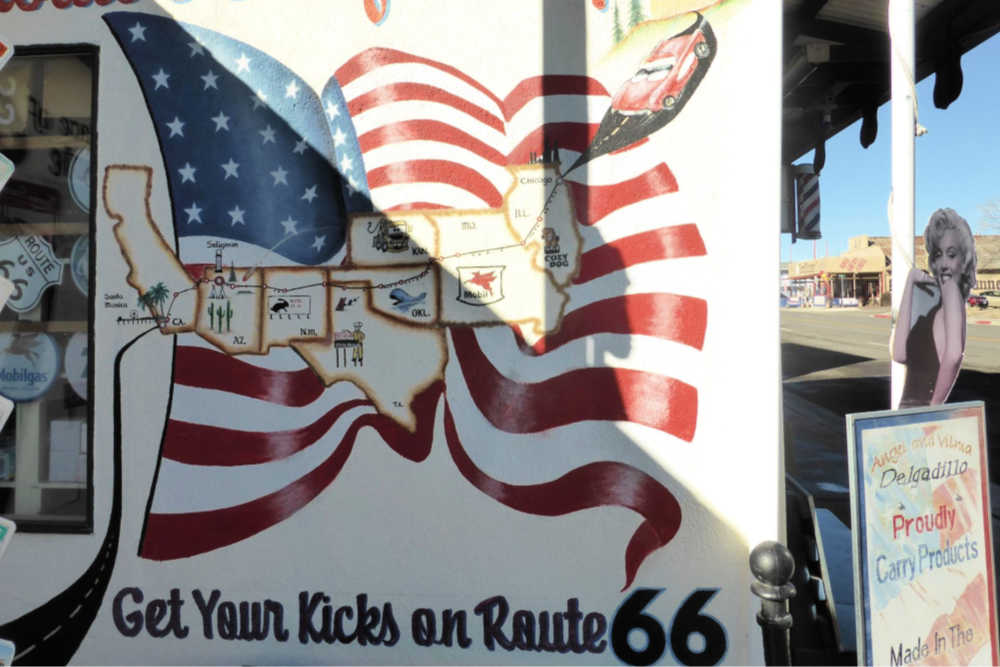
This post may contain affiliate links. Please read our full disclosure policy here.
To enjoy this itinerary you will need your own vehicle, it is not possible to do this trip otherwise. By having your own car you can explore at your own pace, make alterations to the itinerary to suit your requirements or just suddenly decide to stop and explore something you see on your travels.
So let’s hop in the car and take a 7-day road trip from Las Vegas to the Grand Canyon and beyond!
GRAND CANYON & LAS VEGAS ROAD TRIP OVERVIEW
- Travel to Las Vegas
- DAY 1: Drive the Strip | Scenic Drive Across Northwestern Arizona | Scenic Drive from Kanab/Fredonia to Page | Glen Canyon Dam
- DAY 2: Tower Butte | Antelope Canyon | Horseshoe Bend | Grand Canyon
- DAY 3: Scenic Drive from Flagstaff through Sedona | Montezuma Castle | Bell Rock | Chapel of the Holy Cross | Airport Overlook | Unique McDonalds | Meteor Crater | Lowell Observatory
- DAY 4: Drive Route 66 | Seligman | Grand Canyon Caverns | London Bridge
- DAY 5: Grand Canyon West | Skywalk | Hoover Dam
- DAY 6: Las Vegas Sign | Explore the Las Vegas Strip
- DAY 7: Valley of Fire State Park | National Atomic Testing Museum | Pinball Hall of Fame | Ethel M Chocolates
- Travel Home from Las Vegas
Click the link on the “DAY” to quickly jump to that section of this itinerary.
GRAND CANYON & LAS VEGAS ROAD TRIP MAP
Please feel free to download this map for your personal use when planning your trip.
To download this Google Map, click on the grey star at the top of the map and this map will be added to your Google Maps account. You can then view it on your phone or computer in Google Maps by clicking on the menu button, going to “Your Places” and selecting this map.
We use these maps in the planning stage of creating all our itineraries as you can set out your plan in advance and then quickly reference these maps through the planning process.
LAS VEGAS TO PAGE
Drive the Strip | Scenic Drive Across Northwestern Arizona | Scenic Drive from Kanab/Fredonia to Page | Glen Canyon Dam
We’ll explore more of Las Vegas later in the trip, but it’s worth driving north out of the city along the famous strip. You can get your first glimpse of the elaborate hotels, landmarks and gimmicks that are designed to draw you in and gamble.
With Las Vegas behind you, you quickly enter the desert landscape of Nevada towards Arizona. The relatively short trip across northwest Arizona will take you through the mountainous country where it looks as if the road must just end. There doesn’t appear at times to be a path the road can take through the hills. The road curves through the mountains along the rough path of Virgin River allowing you to enjoy some impressive scenery.
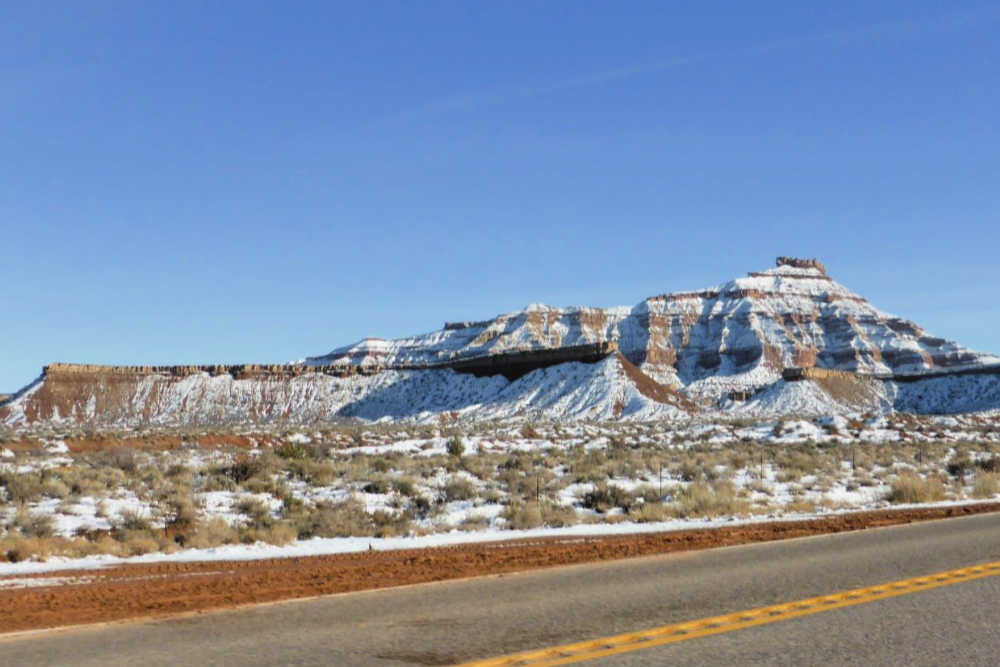
Entering Utah for the first time today you’ll pass through St George before heading back south and into Arizona once more. Once you arrive at Fredonia you can choose whether to take US-89 or US-89A to Page. Both are scenic drives, so which you take is up to you. If you are short of time, US-89 is quicker. It takes you back into Utah and across the bottom of the Grand Staircase-Escalante National Monument.
If you choose US-89A, you’ll stay in Arizona and head across the Vermilion Cliffs National Monument and Marble Canyon where you can see Navajo Bridge and see the Colorado River which carved the Grand Canyon over the millennia. If you want to add a trip to the Northern Rim of the Grand Canyon, you would use 89A and head south from Jacob’s Lake.
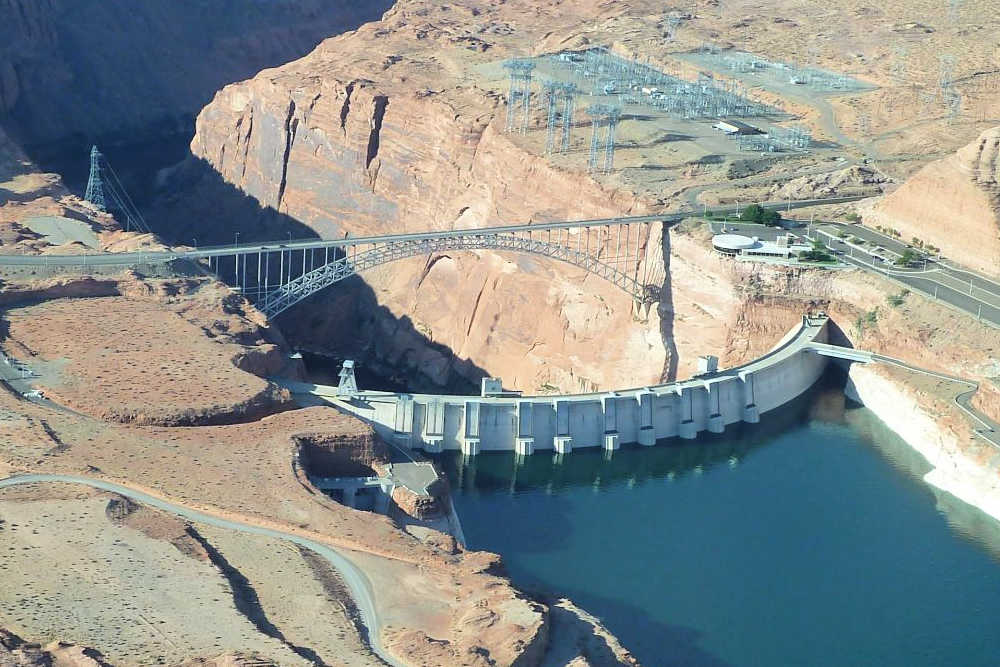
On US-89 you will cross Glen Canyon Dam Bridge, and if you choose US-89A it is worth backtracking along US-89 from Page to visit here. You can pull over at one side of the bridge and walk back across in order to take in the impressive view of Glen Canyon Dam which holds back Lake Powell and uses it to generate electricity.
WHERE TO STAY IN PAGE
RECOMMENDED: 2 Bedroom Townhouse (Airbnb) in Page
We found this house to be a comfortable place to stay with lots of space. It’s really well-located in Page and though we only stayed a single night would have no hesitation in recommending it.
You can check out these alternative Airbnbs in Page or here are some ideas for hotels in Page if you’d prefer that instead.
NEW TO AIRBNB? Click for a discount on your first booking when you sign up for a new account.
PAGE TO FLAGSTAFF
Tower Butte | Antelope Canyon | Horseshoe Bend | Grand Canyon
The second day of your trip will find you up early to begin a day of seeing mother nature at it’s incredible best. The first stop is a once in a lifetime adventure to the top of Tower Butte. Only accessible by helicopter, unless you are a very skilled climber, the butte juts up almost vertically from the desert floor. This trip begins from Page Airport where you’ll meet your pilot and go through a safety briefing. You then board the helicopter for a trip across Lake Powell and up to Tower Butte. The pilot will land the helicopter so you can get out and explore the area and take in the breathtaking views. It really does feel like you are on top of the world.
If Tower Butte doesn’t appeal, then check out these other great options from Page.
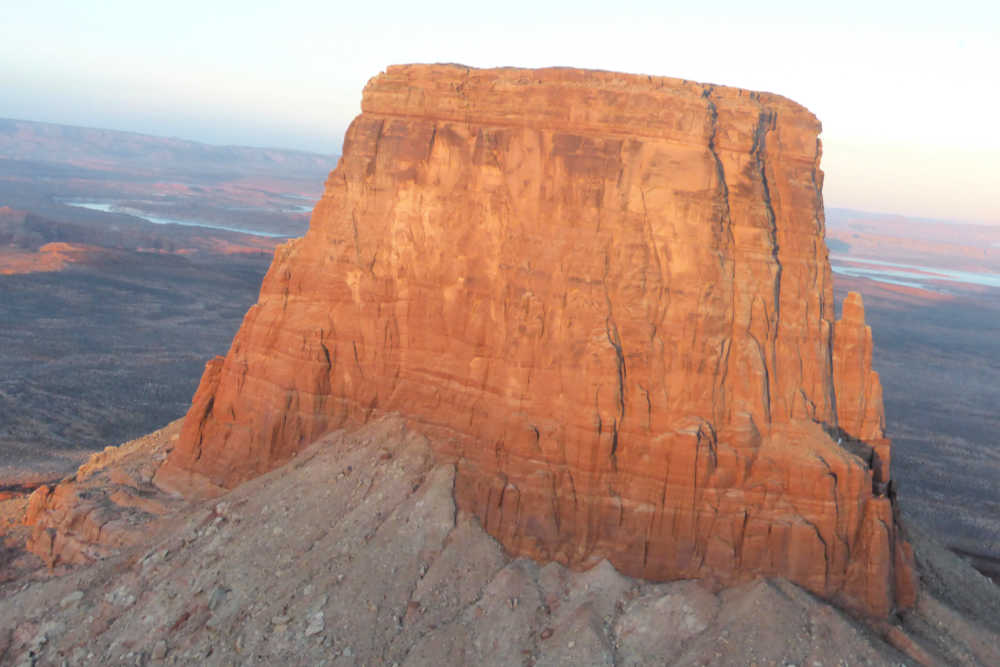
Having started the day with such an adventure, thankfully the rest of the stops don’t disappoint! The next stop is to take a trip to Antelope Canyon, a slot canyon on native Navajo land just outside Page. Tours begin from offices within Page and they take you out to the canyon in small groups. Your guide will walk you the length of the slot canyon and point out interesting shapes and images that the wind and water have marked in the rocks.
Heading south out of Page, it’s worth stopping at one of the most photographed things in the area, Horseshoe Bend. This natural formation on the Colorado river is worth the walk, out from the parking lot to see. The dramatic juxtaposition of the calm looking water with the knowledge that it carved this canyon over thousands of years is thought-provoking.
After three beautiful wonders of nature, it’s time to head to the biggest in the area, the Grand Canyon. Once you’ve entered Grand Canyon National Park your first stop should be at Desert View Watchtower. Here you can see a fantastic view of the canyon, up the Colorado River ahead of you and down to the left. Climbing the watchtower takes you 80ft (21 m) higher and offers panoramic views of the area.
A short distance west is Tusayan Ruin and Museum which is the remains of a small Ancestral Puebloan village. The design of the desert watchtower is in the style of Ancestral Puebloan. You can visit the small museum and walk the short trail around what is left of the village.
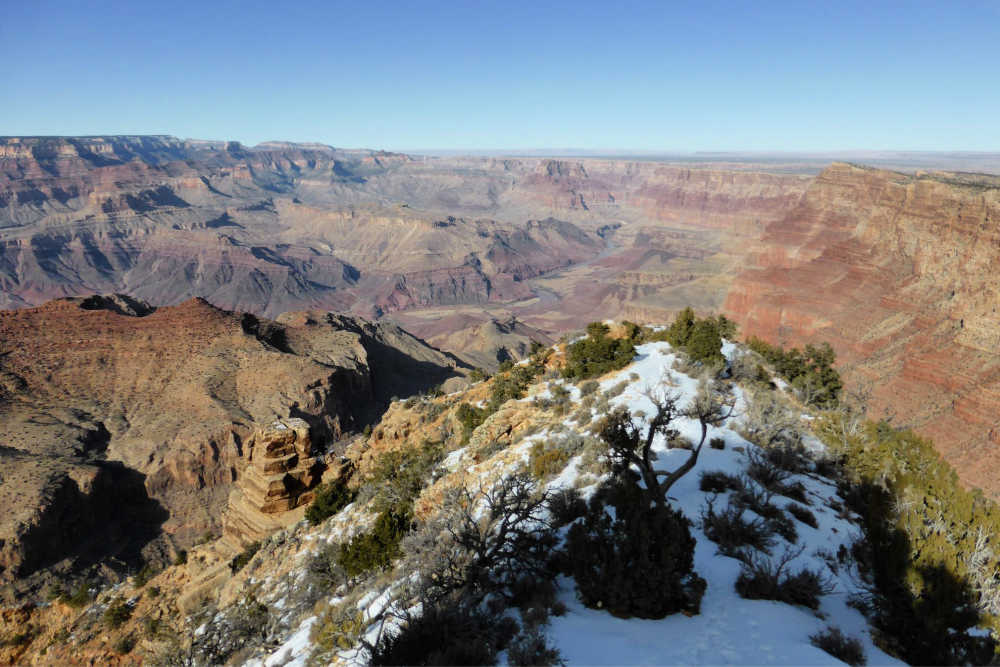
Continuing along the Canyon edge road US-64, there are many places you can stop to take in more views of the canyon. We’ve marked the ones we stopped at on the map which are Grandview Point, Yaki Point, Yavapai Point, Maricopa Point, Mohave Point and Hermit’s Rest. The last three are beyond Grand Canyon Village and can only be accessed by the shuttle buses during high season which run regularly between the village and Hermit’s Rest.
If you can stay at the canyon for sunset, then we recommend Hopi Point. Here you’ll have excellent views to the west to watch the sun fall below the horizon and see the many changing colours of the canyon as the light fades.
WHERE TO STAY IN FLAGSTAFF FOR TWO NIGHTS
Unfortunately, the lovely self-contained apartment in the host’s house we stayed at in Flagstaff isn’t available on Airbnb anymore so we don’t have any personal recommendations for Flagstaff.
You can check out these alternative Airbnbs in Flagstaff or here are some ideas for hotels in Flagstaff if you’d prefer that instead.
NEW TO AIRBNB? Click for a discount on your first booking when you sign up for a new account.
FLAGSTAFF TO SEDONA
Scenic Drive from Flagstaff through Sedona | Montezuma Castle | Bell Rock | Chapel of the Holy Cross | Airport Overlook | Unique McDonalds | Meteor Crater | Lowell Observatory
The first stop today is the furthest south, so you can get there more quickly by using I-17 and just coming back on AZ-179 and AZ-89A, but we recommend using the smaller roads both ways and enjoying the more scenic drive. You can make a brief stop at Oak Creek Vista to look over the valley you are about to visit if you wish. Then return to your vehicle and descend rapidly through multiple sharp turns and hairpins to the valley floor. You follow the valley down through Sedona and it’s stunning red rock scenery before briefly joining I-17 to get to Montezuma Castle.
Montezuma Castle is an 800-year-old “apartment-complex” set high up in the cliffs and was inhabited by people called Sinagua. The castle was one of the original four national monuments of the USA under the Antiquities Act such is its historic importance. The homes have survived so well due to their protection from the elements and the visitors centre even asks “Will your home look this good in 800 years?”. You can’t enter what remains of the houses today, only view them from the trail at ground level.
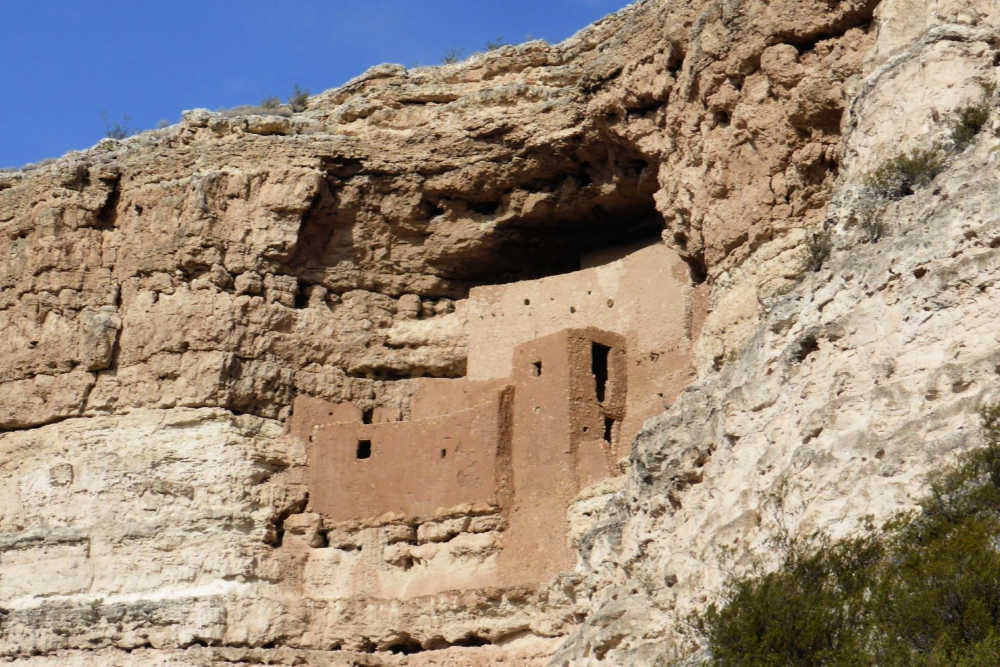
Heading back north towards Sedona, a popular tourist stop is Bell Rock. This butte is believed by some to have a high concentration of spiritual energy and has become a place of meditation. The next stop on the itinerary is also a place where people can meditate, even if you aren’t religious, the Chapel of the Holy Cross is worth visiting. The building appears to almost rise from the surrounding rocks, with a giant cross on the front, which is both aesthetic and structural. The views of the red rocks from the windows and the sunlight streaming through the stained glass are quite beautiful.
If you aren’t tired of the views of the amazing red rock scenery, then a stop at the Sedona Airport Scenic Lookout gives you a view across Sedona and to the beautiful red rock backdrop behind it from a great vantage point. Heading down into Sedona itself, we had to make a quick stop at a unique Mcdonalds. Sedona has strict rules for buildings and can veto anything they think doesn’t fit in with the surroundings. So when McDonald’s wanted to build a restaurant, they were told the famous yellow of their arches was unacceptable. So this McDonalds has turquoise arches instead!
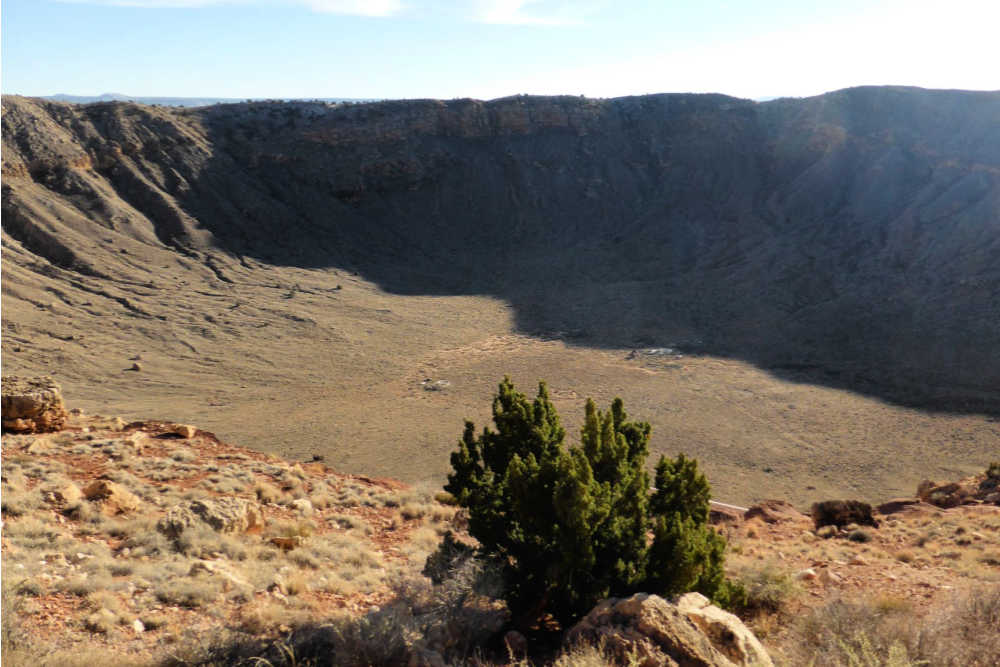
After enjoying the scenic drive back towards Flagstaff, the next stop on the itinerary is a meteor crater. Though basically just a big hole in the ground, it’s quite amazing to imagine the impact required to make this big a dent in the surface of the Earth. The impact happened 50,000 years ago and the crater today is one of the best-preserved impact craters anywhere. The meteorite that created the crater is thought to have been about 150 ft (45 m) across and created a crater almost a mile (1.6 km) across and 550 ft (167 m) deep!
The final stop on today’s itinerary is an evening stop at one of the oldest observatories in the US, Lowell Observatory. Opened in 1894 and famous for discovering Pluto a visit to the observatory allows you to learn more about the solar system and universe, but also take a peek through some of their telescopes. On the day we visited we were able to view the Andromeda galaxy which is about 2.5 million light-years from Earth. To think that the light you are seeing left the stars of another galaxy over 2.5 million years ago is quite amazing.
After a long day sight-seeing, it’s time to return to your accommodation in Flagstaff for another night.
FLAGSTAFF TO DOLAN SPRINGS
Drive Route 66 | Seligman | Grand Canyon Caverns | London Bridge
Heading west out of Flagstaff it’s time to drive a part of the Mother Road, the iconic Route 66. One of the original US highways and the first to be completely paved, it gained cult status with references in hit songs and a tv series. Though no longer part of the US Highway system, the roads fame has kept parts of the route, that originally ran from Chicago to Santa Monica, alive.
The small town of Seligman is a great place to stop and drink in the nostalgia of Route 66. Once on the primary route west in the area, it is now bypassed by I-40 and hence passing trade has fallen dramatically. The small town offers food and beverages, a well-stocked gift shop and lots of memorabilia from the glory days of Route 66. Keep an eye out for Delgadillo’s Snowcap car with its funky decorations which include a Christmas tree on the back! As you continue on Route 66, you’ll see some of the old Burma-Shave advertising signs which told a short tale or joke across several signs.
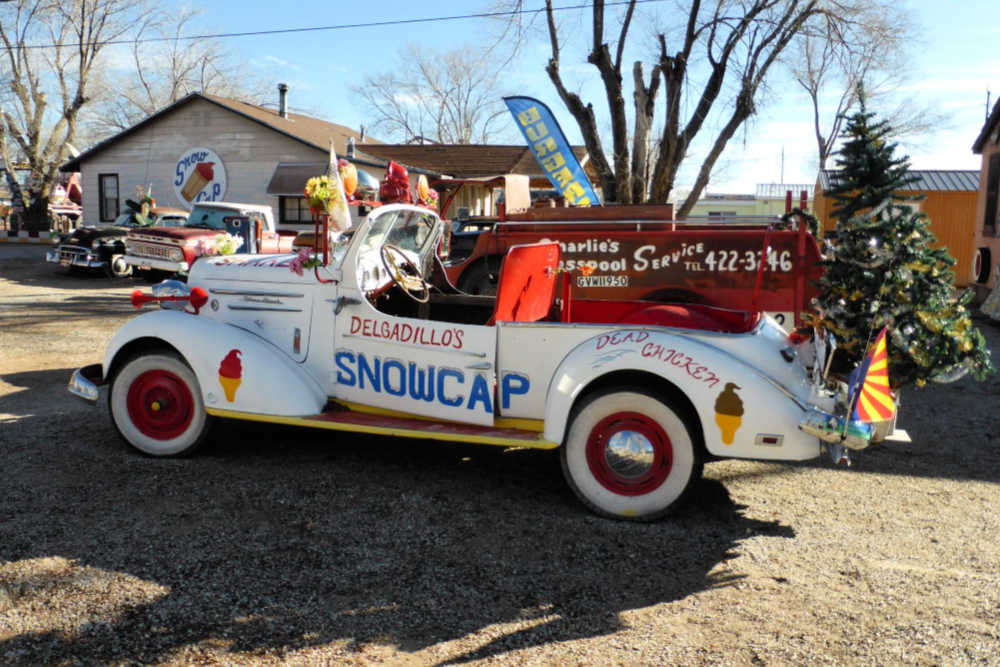
A great stop on this part of Route 66 is Grand Canyon Caverns. These are among the largest dry caverns in the USA and because they are dry don’t feature the stalactites and stalagmites of the more common wet caverns. The caverns offer several different tours depending on how much time you want to spend and how deeply you want to explore the caverns.
The regular tour that we took takes about 45 minutes and visits the main areas of the caverns. You’ll see the stores that were placed here for when it was intended to be a fallout shelter, the suite which you can book to stay in overnight and the many varied rock formations that were created millions of years ago.
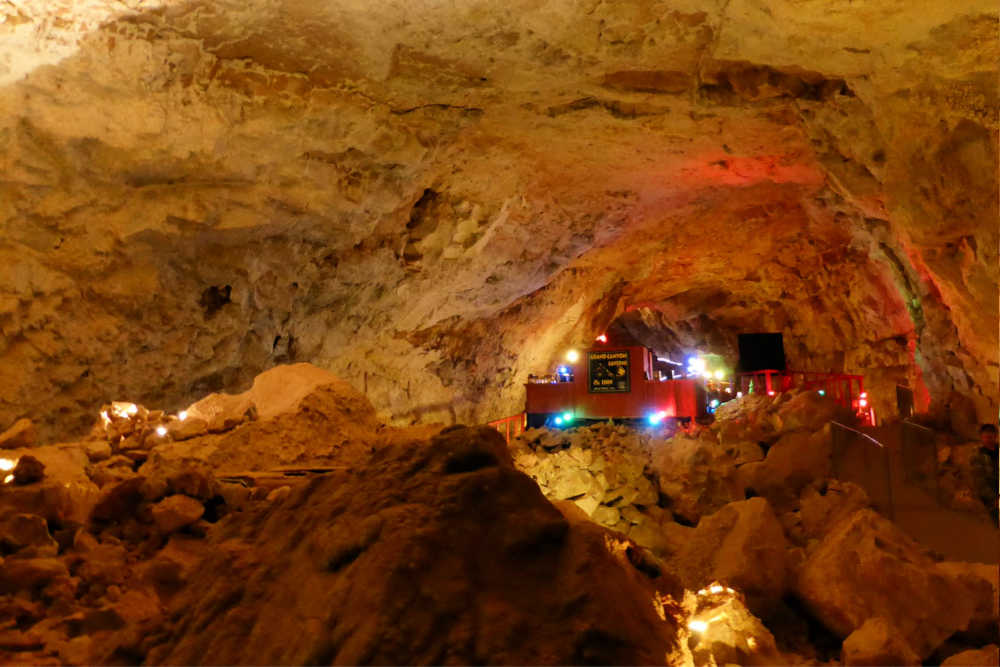
Leaving the caverns, it’s time to spend another hour driving on Route 66 to Kingman. From here, our itinerary was to head south to Lake Havasu, it’s quite a drive “out of the way”, but this was probably the closest we might ever be to go and see London Bridge, so we went for it.
The bridge from Lake Havasu City to a small island in the Colorado River really is London Bridge and was shipped over stone by stone by chainsaw magnate Robert P. McCullock and reassembled in Lake Havasu City. His intention was to put the city on the map, and in that, he succeeded, as the bridge is now the second most visited attraction in Arizona, after the Grand Canyon.
From Lake Havasu, we headed back north to stay as close as we could to our early morning stop the next day.
WHERE TO STAY IN DOLAN SPRINGS
Unfortunately, the cool place we stayed, which was also an ostrich farm, in Dolan Springs isn’t available on Airbnb anymore so we don’t have any personal recommendations for Dolan Springs.
We chose Dolan Springs in order to be as close as possible to our early morning activity the next day and it is a very small and rustic town which may not be to everyone’s tastes. The nearest bigger town is Kingman about 40 minutes south.
You can check out these alternative Airbnbs in Dolan Springs or there is one hotel in the nearby Chloride or here are some ideas for hotels in Kingman if you’d prefer that instead.
NEW TO AIRBNB? Click for a discount on your first booking when you sign up for a new account.
DOLAN SPRINGS TO LAS VEGAS
Grand Canyon West | Skywalk | Hoover Dam
It’s time to head back to the Grand Canyon today, about 90 miles (145 km) west of where we saw it at Hermit’s Rest. This part of the canyon is on the Hualapai Indian Reservation land rather than the National Park Service and they offer activities which the park service doesn’t. For us this meant taking a second helicopter trip down into the canyon, landing at the bottom and then rafting a short distance along the Colorado River.
After checking in at Grand Canyon West you’ll take the short 5-7 minute flight over the canyon rim and down 4,000 ft (1200 m) to the canyon floor where the helicopter will land. You then walk a short distance to get on board a pontoon boat for a 15-20 minute float along the Colorado River with the walls of the canyon towering above you. Like the trip to the top of Tower Butte at the start of the itinerary, this is an amazing experience and one you’re sure to remember for many years to come.
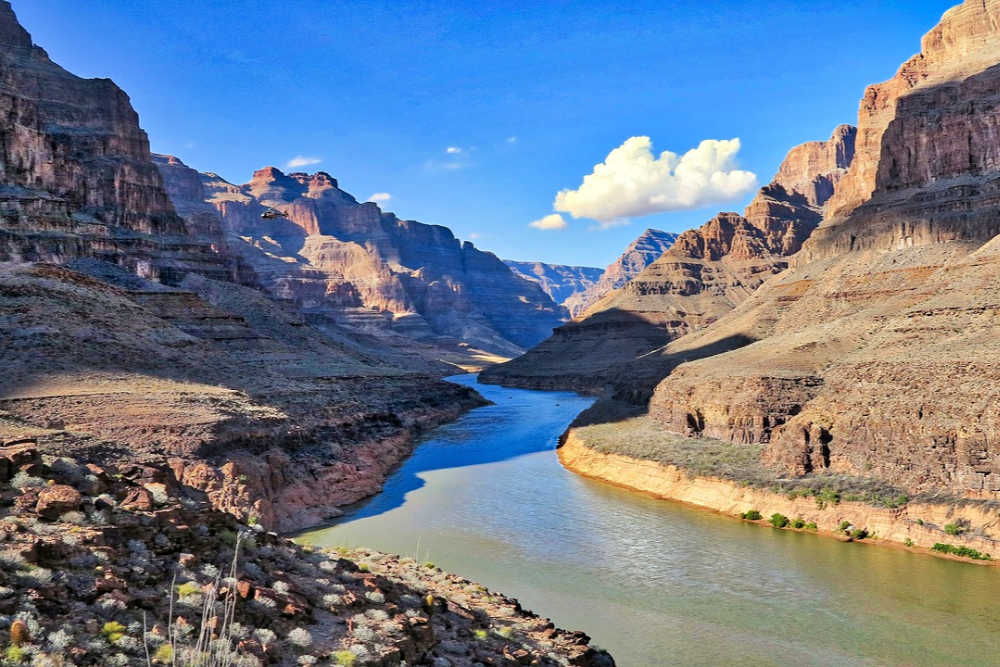
Once your helicopter flight returns, you can explore other parts of Grand Canyon West. There is a bus service that takes you to several different stops that are included within your entrance ticket. One of the biggest attractions here is the Skywalk which is a U-shaped glass walkway that extends out over the canyon edge allowing you to look directly down into the canyon. You can also explore Guano point where you can walk out along a fairly narrow peninsula to a grand view of the canyon. Here you’ll also found what’s left of a cable car station which used to provide access to a guano mine. The final main stop is Hualapai Ranch which is a small “wild west” town.
EDITOR’S NOTE: If you want to visit the Skywalk or land at the bottom of the canyon, your only option is to pay the entrance fees for Grand Canyon West. The prices are exorbitant and we found the service and customer focus to be lacking. Once they have your money, they didn’t seem interested in much else. We saw people complaining and being simply brushed off, no matter how valid their issue. We, therefore, cannot recommend a visit to Grand Canyon West, though we fully understand people will take the risk due to the unique attractions it offers. Caveat Emptor.
Leaving the Grand Canyon behind it’s time to head back to Nevada and Las Vegas with one last stop en route. Straddling the border of Arizona and Nevada and two timezones, Mountain Standard Time and Pacific Time Zone, Hoover Dam is on the Colorado River that formed the Grand Canyon and that we saw way back on day 1 at Glen Canyon Dam. The dam holds back Lake Mead, which is the largest man-made lake in the USA and the dam itself is the second tallest in the country.
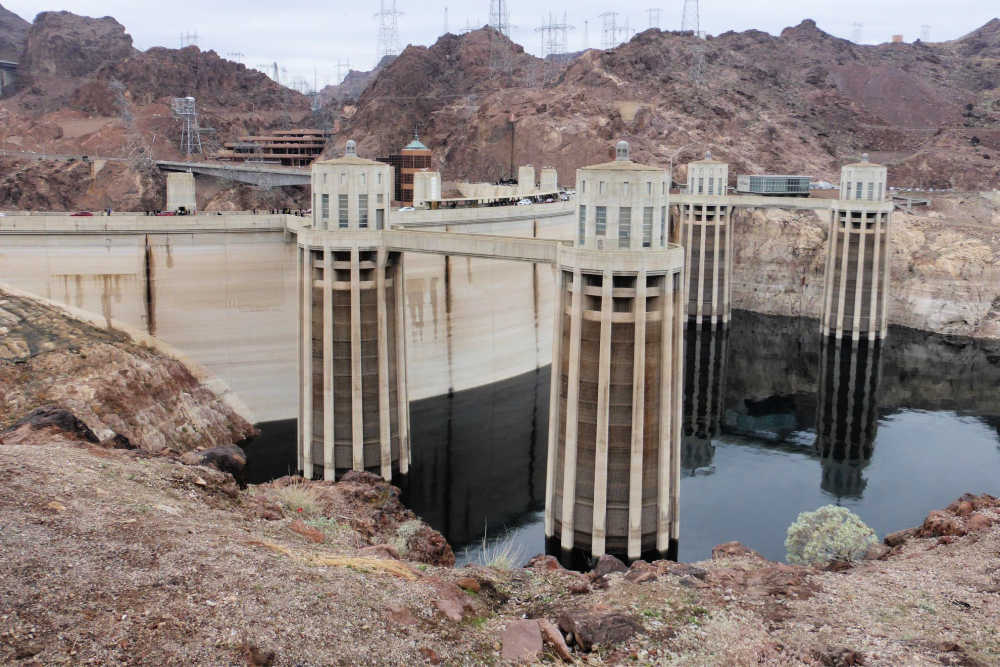
The road to Las Vegas used to go across the top of the dam, but you now cross the river on a large bridge that bypasses the dam, which provides visitors coming from Arizona a great view of the dam as the cross. Once you enter the dam area past security you can still drive across the roof of the dam to the lookout points that provide views of the back of the dam and Lake Mead. To get a greater understanding of the dam and its history you can do tours inside the dam.
The guided dam tour takes visitors into the dam’s interior where you can see information about how the dam was built and explore some of the original art-deco decorations. The tour will show you the Nevada powerhouse which houses 8 generators in one of the two powerhouses within the dam. You’ll then get to walk down an inspection tunnel which allows you to peer out of the concrete face of the dam and down the Colorado River before riding an original elevator back to the top of the dam. The tour is very interesting and makes a stop at Hoover Dam well worth the time before heading to Las Vegas.
WHERE TO STAY IN LAS VEGAS FOR THREE NIGHTS
Unfortunately, the excellent apartment in a gated community we stayed at in Henderson (just south of Las Vegas) isn’t available on Airbnb anymore so we don’t have any personal recommendations for Las Vegas.
However, there is no place on earth with more choices of hotels and places to stay than the gambling capital of the world… You can check out these alternative Airbnbs in Las Vegas or here are some ideas for hotels in Las Vegas if you’d prefer that instead.
NEW TO AIRBNB? Click for a discount on your first booking when you sign up for a new account.
LAS VEGAS STRIP
Las Vegas Sign | Explore the Las Vegas Strip
There’s no better place to start a journey of discovery up the Las Vegas Strip than the world-famous Welcome to Las Vegas sign. Erected in 1959, the 25 ft (7.6 m) tall sign the most well-known symbol of Las Vegas and is generally seen to denote the southernmost end of the famous strip.
There are a plethora of sights along the strip vying for your attention, and as it stretches over 6.5 miles (10.5 km) from the Las Vegas sign to the Fremont Street Experience so you probably won’t have time to visit them all in a day. As most casinos now charge for parking, you’ll most likely want to park at a single casino for the day and then make use of public transport. You can travel the length of the strip on the regular Deuce buses for just $8 per day or $20 for a three-day pass.
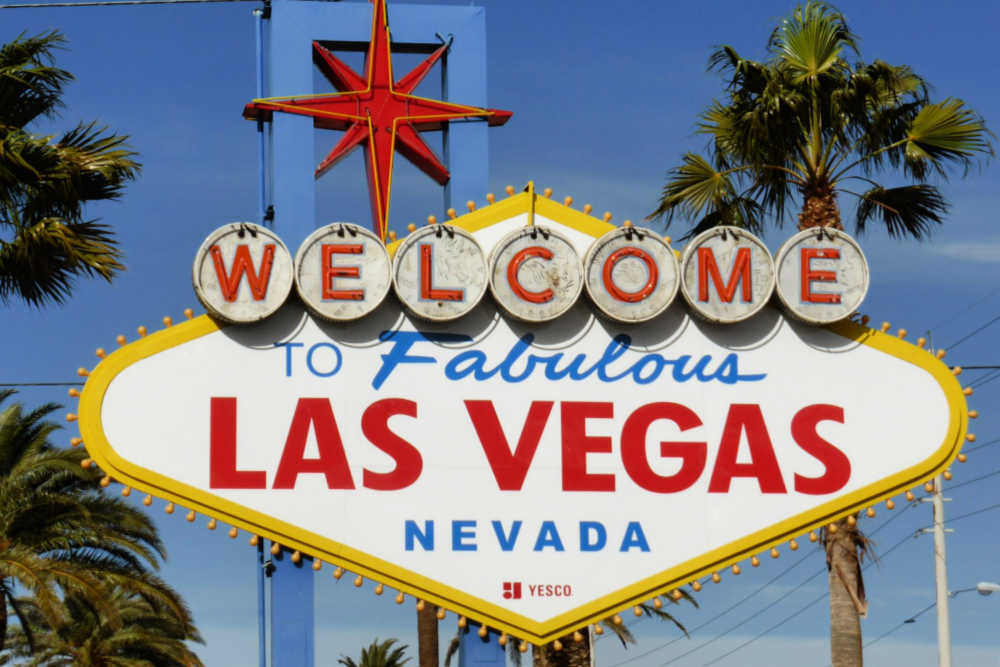
The four hotels below are all relatively close together and can easily be visited by parking at any one of them for the day.
The Bellagio is one of the most famous hotels on the strip and it’s worth stopping by to see the fountains if you can. Choreographed to music, the fountains shoot water as high as 460 ft (140 m) into the air for the man-made lake in front of the hotel. Inside the hotel, renowned for its elegance you’ll find exquisite decorations including 2,000 hand-blown glass flowers on the lobby ceiling.
Caesars Palace’s theme is ancient Greece and Rome and the hotel abounds with statues and columns to provide a Greco-Roman feel. One of the most impressive statues is the 20 ft (6 m) high statues of Julies Caesar apparently hailing a taxi in the entrance! Caesar’s was one of the first hotels in Vegas to focus on shopping with the opening of The Forum Shops. The Forum features spiral escalators, replicas of famous fountains and all the high-end shops you would expect.
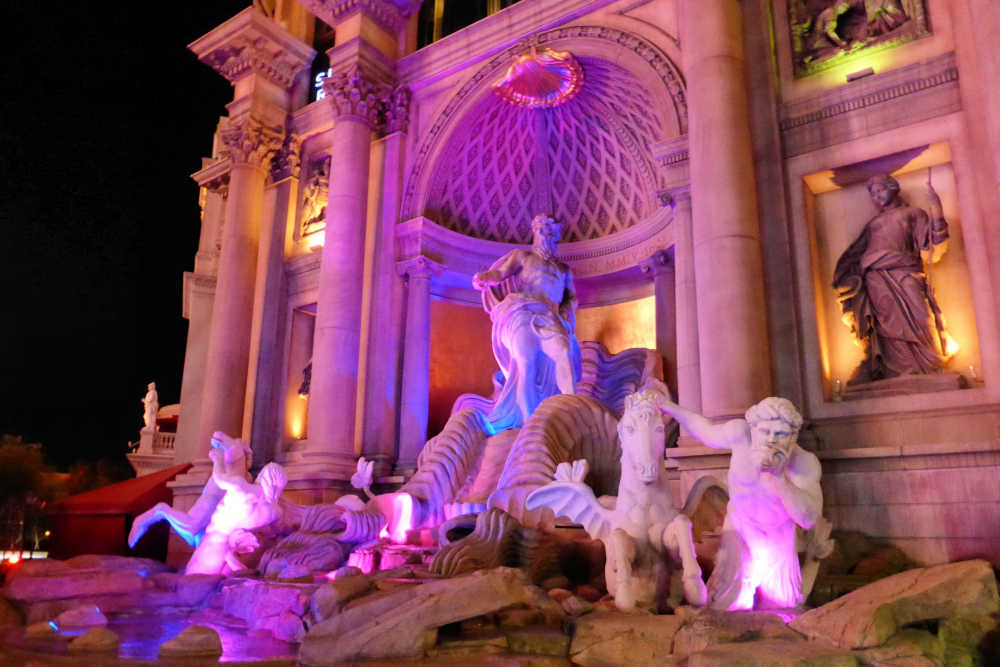
The Mirage was the first of the new breed of hotels that lead to the extravagant Vegas you see today. It has a Polynesian theme and includes a huge aquarium behind the reception desk which is home to almost 1,000 creatures. The most famous attraction at the Mirage is the “volcano” which erupts several times a night outside the hotel. The effect is very impressive and you can feel the heat from the “magma” as it “erupts”.
Finally, for our small selection of the many hotels along the strip, we come to The Venetian. Themed as the name suggests after Venice in Italy, the Venetian has replicas of St Mark’s Campanile and the Rialto Bridge as well as plenty of waterways to mimic the canals. Inside you’ll find beautifully decorated ceilings and arcades as well as Venetian streets where the ceilings are painted so they appear to be the sky. You can even take a gondola ride along the canals, though unlike in Venice itself, the canals here are crystal clear and the gondolas are electrically propelled.
There are plenty of other attractions to fill your day along the famous strip. Whether you try your hand at cards or your luck at roulette or the slots in one of the many casinos. Watch one of the dozens of shows that the casinos put on or just explore the many attractions. You can ride a rollercoaster through a casino or zipline starting inside the world’s largest slot machine, the possibilities are endless.
LAS VEGAS AREA
Valley of Fire State Park | National Atomic Testing Museum | Pinball Hall of Fame | Ethel M Chocolates
For the final day of this road trip, we are heading out to see the sights of Las Vegas beyond the strip.
The first stop is Valley of Fire State Park to the northeast of the city. Here you’ll find 40,000 acres of bright red sandstone to explore which looks amazing in the sunlight. There are several trails you can walk and photo stops with names such as Crazy Hill, Mouse’s Tank and Elephant Rock to explore and the park contains ancient petroglyphs as well as petrified trees. The visitor centre has exhibits on the geology of the area to help you better understand the ecology and history of the park.
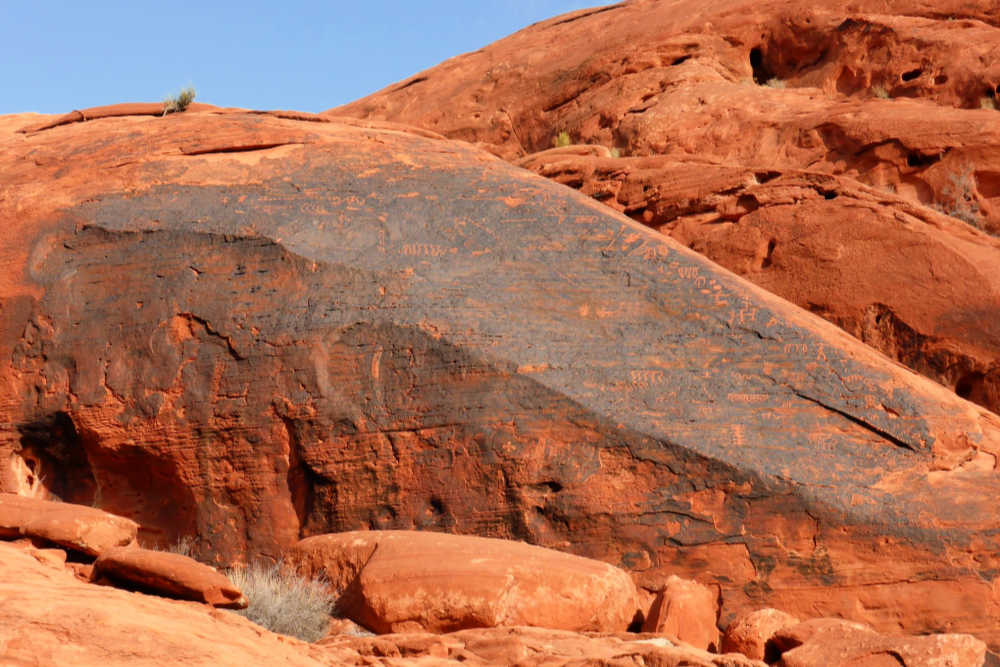
Back within the city limits, the next stop is the National Atomic Testing Museum which tells the history of nuclear testing at the Nevada Test Site. Before above-ground nuclear testing was banned, people would come to Vegas to watch the bright flash of the nuclear test in the distance! The museum traces the earliest tests at the site through the transition to underground testing and after nuclear testing was banned. Visitors can experience a simulation of an above-ground test as well as explore the many exhibits including products from the Atomic Age. The museum also has an exhibition about the fabled Area-51 which is located about 80 miles (130 km) northwest of Las Vegas.
A very different museum is next up, one where you are actively encouraged to play with the exhibits. The Pinball Hall of Fame provides visitors with over 150 pinball machines which you can play for just 25 or 50 cents a play. If you used to enjoy pinball or were even a pinball wizard, there is sure to be some machines here that bring back memories. But even if not, you can easily while away some time enjoying playing the silver ball. The museum is not-for-profit and has a thrift store feel, but that’s because pretty much all their focus is on the pinball machines.
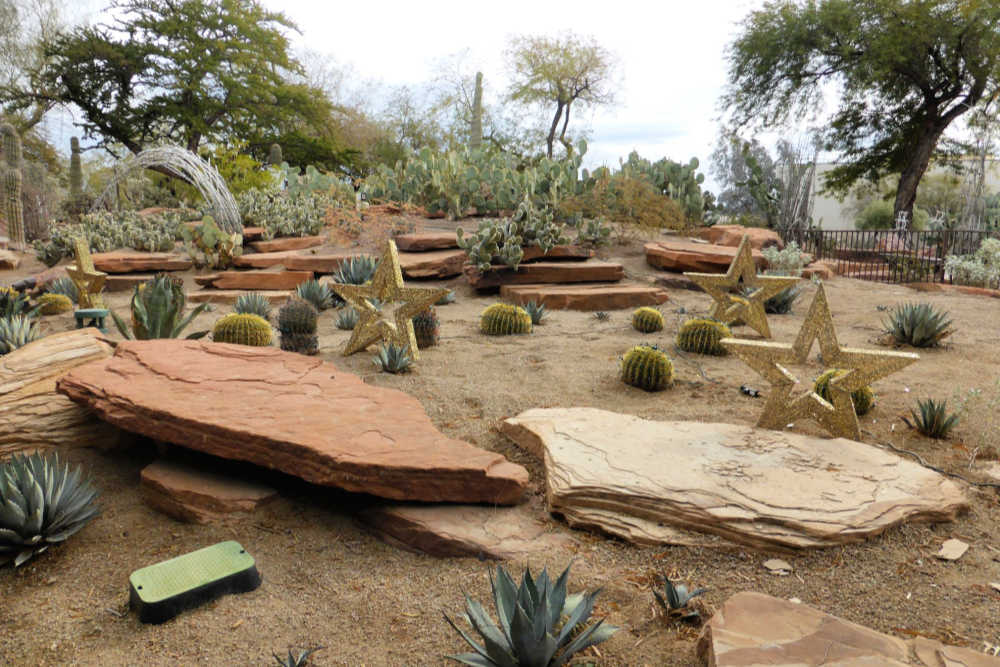
Our final stop on the itinerary will tantalise the tastebuds as we visit Ethel M Chocolate Factory. Founded by Forrest Edward Mars Sr. of the Mars chocolate family after he retired, Ethel M Chocolates is named after his mother and is now owned by Mars Inc. You can view the making of chocolates through the large glass windows into the production plant before entering the shop where you can taste and purchase some of the delectable confectionery. Outside the factory is a Botanical Cactus Garden, three acres of cacti and other succulents that visitors can explore at the leisure.
BEST TIME TO TAKE A GRAND CANYON & LAS VEGAS ROAD TRIP
In our opinion, the best time to visit Las Vegas and the Grand Canyon is outside of the searingly hot summer months where temperatures can be over 40°C (104°F). Even in winter, temperatures are generally mild and attractions are quieter without the summer crowds.
We visited in late December and found everything we wanted to visit was open and only the very biggest sights had any crowds. In some cases, we had “private” tours as we happened to be the only people visiting a particular attraction at the time which was fantastic!
In the summer (June to mid-September) the days are long (like 09:00 pm sunsets), the weather is extremely hot, and every sightseeing attraction, B&B, and hotel is open. However, with this, you’ll also find the biggest crowds, especially in the most popular areas such as Las Vegas itself, the Grand Canyon and attractions like the Hoover Dam. This is also the time of year where airfare, car rental, and hotel prices will be the highest.
In the winter (November – February) there are fewer daylight hours and in some cases, you might find reduced opening hours for attractions, and it’s possible that some of the smaller attractions may be closed altogether. The weather is still reasonably warm and dry, which is great as so much of this itinerary is outside, and you are likely to find great prices on airfares, hotels, and B&Bs.
Want to save this for later? Click the Pinterest button on the left for a pinnable image!
RESOURCES | PLAN YOUR GRAND CANYON & LAS VEGAS ROAD TRIP
To book flights, rental cars, accommodations, and activities for your trip, please check out our recommended travel providers, favourite apps and websites.
Some of the links in the post above are affiliate links. This means if you click on the link and purchase the item, we will receive an affiliate commission but this does not affect the price to you. Please read our full disclosure policy here.




